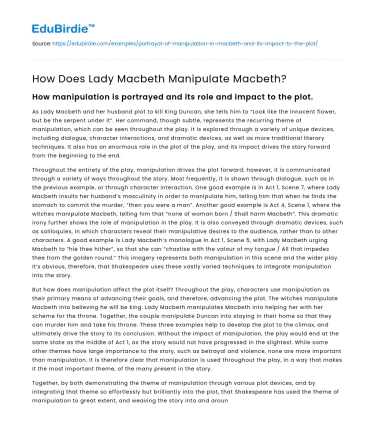How manipulation is portrayed and its role and impact to the plot.
As Lady Macbeth and her husband plot to kill King Duncan, she tells him to “Look like the innocent flower, but be the serpent under it”. Her command, though subtle, represents the recurring theme of manipulation, which can be seen throughout the play. It is explored through a variety of unique devices, including dialogue, character interactions, and dramatic devices, as well as more traditional literary techniques. It also has an enormous role in the plot of the play, and its impact drives the story forward from the beginning to the end.
Throughout the entirety of the play, manipulation drives the plot forward; however, it is communicated through a variety of ways throughout the story. Most frequently, it is shown through dialogue, such as in the previous example, or through character interaction. One good example is in Act 1, Scene 7, where Lady Macbeth insults her husband’s masculinity in order to manipulate him, telling him that when he finds the stomach to commit the murder, “then you were a man”. Another good example is Act 4, Scene 1, where the witches manipulate Macbeth, telling him that “none of woman born / Shall harm Macbeth”. This dramatic irony further shows the role of manipulation in the play. It is also conveyed through dramatic devices, such as soliloquies, in which characters reveal their manipulative desires to the audience, rather than to other characters. A good example is Lady Macbeth’s monologue in Act 1, Scene 5, with Lady Macbeth urging Macbeth to “hie thee hither”, so that she can “chastise with the valour of my tongue / All that impedes thee from the golden round.” This imagery represents both manipulation in this scene and the wider play. It’s obvious, therefore, that Shakespeare uses these vastly varied techniques to integrate manipulation into the story.
Save your time!
We can take care of your essay
- Proper editing and formatting
- Free revision, title page, and bibliography
- Flexible prices and money-back guarantee
But how does manipulation affect the plot itself? Throughout the play, characters use manipulation as their primary means of advancing their goals, and therefore, advancing the plot. The witches manipulate Macbeth into believing he will be king. Lady Macbeth manipulates Macbeth into helping her with her scheme for the throne. Together, the couple manipulate Duncan into staying in their home so that they can murder him and take his throne. These three examples help to develop the plot to the climax, and ultimately drive the story to its conclusion. Without the impact of manipulation, the play would end at the same state as the middle of Act 1, as the story would not have progressed in the slightest. While some other themes have large importance to the story, such as betrayal and violence, none are more important than manipulation. It is therefore clear that manipulation is used throughout the play, in a way that makes it the most important theme, of the many present in the story.
Together, by both demonstrating the theme of manipulation through various plot devices, and by integrating that theme so effortlessly but brilliantly into the plot, that Shakespeare has used the theme of manipulation to great extent, and weaving the story into and around it.
We can all see, then, how manipulation is demonstrated in Macbeth, and the extent of its role and impact to the plot. We can see it portrayed through multiple devices, including dialogue, character interaction and through dramatic devices. The various examples of manipulation lead to its massive impact and role in the plot, driving the plot further than any of the other theme. Conclusively, when Lady Macbeth recites the now-famous line, Look like the innocent flower, but be the serpent under it, she is unknowingly demonstrating the most important theme in the play, and advancing the story by demonstrating that theme.






 Stuck on your essay?
Stuck on your essay?

